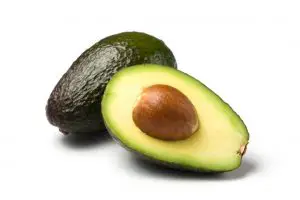French Bulldogs are a breed of dog known for their friendly personalities and gentle nature. They are also very intelligent dogs who love to play and enjoy being around people. Merle French Bulldogs are a rare version of Frenchie that carry the Merle gene.
The French Bulldog is a moderately active breed that loves to run around and play. This makes it a great companion for children, but they do need exercise.

Tidbits About Merle Frenchies
- They’re Rare – Merle is the most rare color pattern, and you don’t see them as often.
- They’re Expensive – Like most rare things in life, their rarity comes with an increased price tag. Expect to pay more for a Merle Bulldog than some other color variations
- Not AKC Recognized – The American Kennel Club (AKC) doesn’t recognize Merle French bulldogs as an official color variation, so they’re not allowed to participate in dog shows. For most people, this isn’t a big deal, but if you’re looking to compete with a breed-standard Frenchie, a Merle French bulldog won’t be allowed.
- Can Have Possible Health Issues – Like many purebred Frenchies, Merles can have health problems. This particular color variation can come with added issues, though.
- Merle is Not an Actual Color – Technically speaking, Merle is not an actual color, but instead, it is a variation of a color pattern, albeit one that is more coveted than others. Frenchie, with these patches of Merle, carries the Merle gene.
What Is A Merle French Bulldog?

Merle French Bulldogs carry a special gene (the Merle Gene) that gives French Bulldogs a unique color pattern. Merles have a variety of exotic colored coats, including shades of blue, red, yellow, orange, pink, and cream. These colors come from the recessive genes in the Merle gene.
This gene mutation causes the hair to grow in patches instead of all over the body. As a result, the dog will have some areas of one color and other areas of another color. They will usually have darker spots of color over an overall lighter base coat.
Black-coated Merles have dark chocolate or black fur on their bodies. Their faces may be lightened up by having a few flecks of white on their nose, ears, cheeks, or forehead.
Cream-flecked Merle’s have a lighter base coat than Black-Coated Merle’s. They often have more white on their faces and paws. Their coats are usually a medium shade of cream or off-white.
How To Identify A Merle French Bulldog
Merle French bulldogs are pretty easy to identify and certainly stand out in a crowd of other dogs. Walk down the street with a French bulldog, and you will be hard-pressed not to get “ooh, a Frenchie!” statements from passersby. I know I get them anytime I am downtown with my Frenchie! When you have a Merle, you get that tenfold!
A Merle French Bulldog can be identified by their notable coat. They often have random patches of darker fur over a lighter coat of fur. As an example, here is a photo of Merle Frenchie. Their genetic makeup results in a pretty attractive and unique coat.
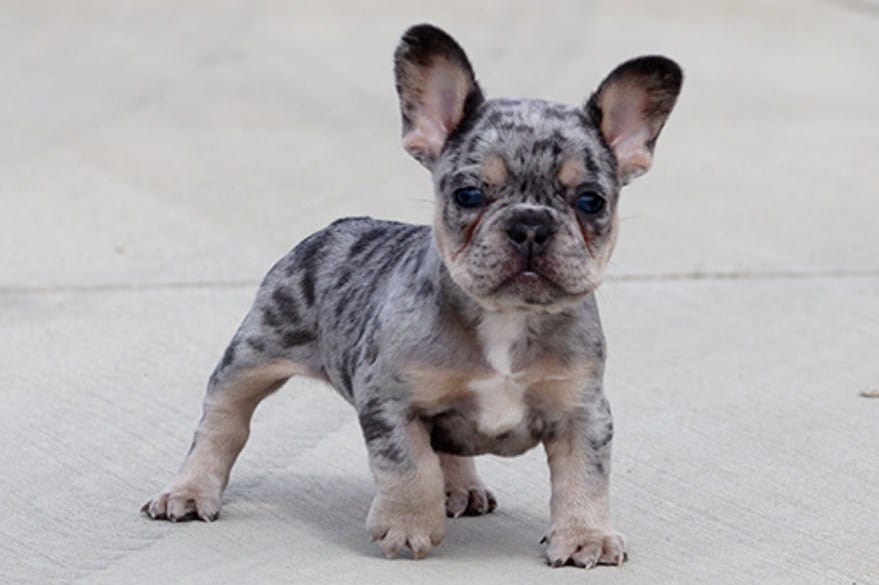
Don’t Confuse A Merle Frenchie With A Brindle Frenchie
I have seen some confusion online when looking at Frenchie puppies and trying to determine if they are true Merle French bulldog puppies. A common mistake that can be made is confusing a Brindle French Bulldog with a Merle French Bulldog.
Merle Frenchies Can Be Confused For A Brindle Frenchie
Especially when they are puppies. They are not the same. The two Frenchie color patterns are actually very different. Merle is a type of color pattern that appears in certain Frenchies, and it shows a diluted base coat color topped with patches or splotches of deeper color pigmentation. However, it’s crucial to distinguish between cryptic merle and ghost merle.
Cryptic merle French Bulldogs have a hidden or minimal expression of the merle pattern, making it challenging to detect with the naked eye. In contrast, ghost merle French Bulldogs display a subtle, almost transparent merle pattern that can be quite elusive, adding an element of mystery and charm to their appearance.
Every Merle French Bulldog Is Different In Appearance
Just like snowflakes, no two Merle French bulldogs are alike. Merle Frenchies can vary in appearance quite dramatically. Check out this picture below of yet another Merle Frenchie cutie.
Here Are Some Of The Common Merle Color Patterns
- Blue merle
- Tan merle
- Lilac merle
- Chocolate Merle
- Red merle
- Black merle
- White merle
- Cream merle
- Etc…
Merle French Bulldog Traits
There are some common traits that Merle Frenchies have in common, even though no two are exactly alike. Some commonalities of Merle Frenchies include dark brown eyes, bright blue eyes, and the tell-tale tri-colored coat. Some more rare versions of Merle French bulldogs can be a Bi-color coat or odd-colored eyes (officially known as Heterochromia iridium).

Types Of Merle French Bulldogs
As I mentioned above, the Merle color pattern can be present in many different coat colors. There are many variations of Merle Frenchies. With that said, the coat colors listed below are some popular variations of the Merle coat:
Merle French Bulldog
As discussed, the Merle French bulldog is a Frenchie with a Merle fur coat color pattern. The unique Merle pattern results in patches of color that are darker or lighter than the base coat color. Merle Frenchies may also have mottling or speckling or mottling in their coat as well.
Black-Coated Merles
Black-coated Merles tend to have dark chocolate or black fur in their fur coats. Merle Frenchies’ adorable flat faces might also be lightened up by having a few flecks of white on their nose, ears, cheeks, or forehead.
Cream-Flecked Merles
Here’s yet another type of Merle Frenchie. Cream-flecked Merle’s tend to have a lighter base coat than Black-Coated Merle’s mentioned directly above. They often have more white on their faces and paws. Their coats are usually a medium shade of cream or off-white.
Blue / Grey Merle French Bulldog
A Blue or Grey Merle Frenchie is a French Bulldog with a Merle coat pattern that has a blueish or grey color. These Blue Merle French bulldogs can have patches of either a darker or lighter blue in their coat. Some will even have tan or white markings. These are impressive-looking Merle Frenchies! The blue Merle Frenchies are absolutely adorable!
Chocolate Merle French Bulldog
This is a Chocolate Merle French Bulldog with a Merle coat color pattern. This Merle Frenchie will have a chocolate-colored base fur coat. This Merle Frenchie, like others, can have patches of darker or lighter color. It might also have white or tan markings on its coat.
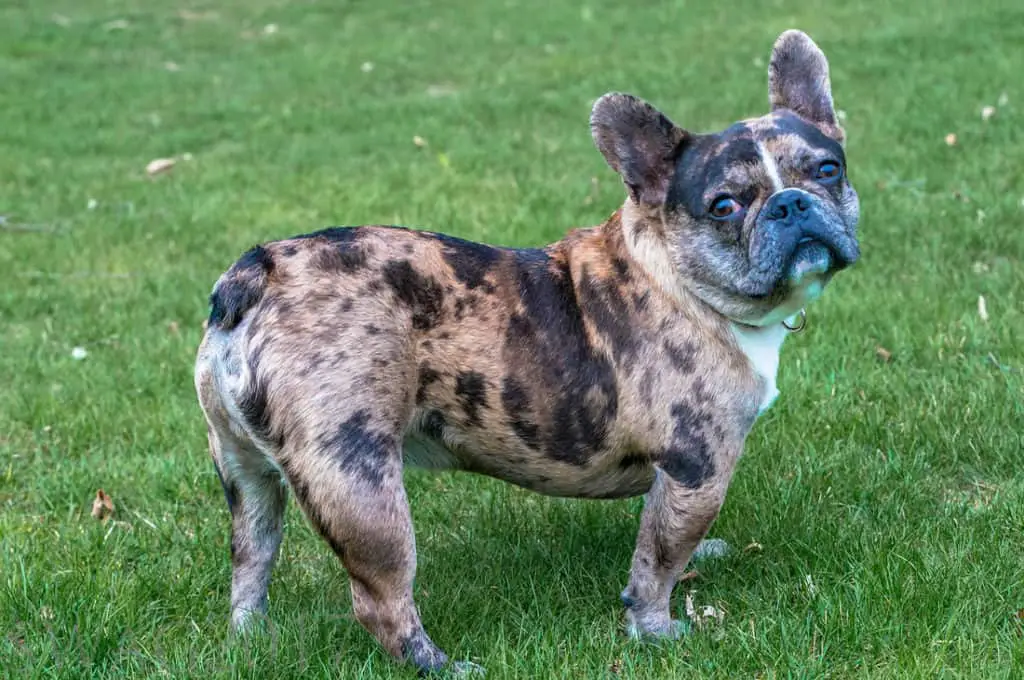
Lilac Merle French Bulldog
Lilac Merle Frenchies are another rare variation of a Merle Frenchie. To achieve the captivating Lilac Fawn Merle coloration in your French Bulldog, specific genetic conditions must be met. This Frenchie must have one copy of the fawn gene located on the A-locus, two copies of the blue gene found on the D-locus, two copies of the chocolate gene situated on the B-locus, and finally, one copy of the merle gene present on the M-locus.
Fawn Merle French Bulldog
This is another Merle Frenchie color variation. To be a fawn merle Frenchie, the puppy must inherit at least one copy of the fawn gene (Ay) on the A locus and also one copy of the merle gene on the M-locus.
Furry Or Fluffy Merle French Bulldog
A Fluffy or Furry Merle Frenchie is a long-haired French Bulldog that also has the Merle coat pattern. Most traditional French Bulldogs have short fur, but a variation of Frenchies with long hair has become popular in recent years. These fluffy Frenchies tend to have long, soft fur.
These furry Merle Frenchies can, of course, have other Merle color variations, including Blue Merle, Chocolate Merle, and other combinations. You should expect to pay more for this rare Merle Frenchie. Below is an example of a Fluffy Frenchie bred by Tom Kings Kennel.
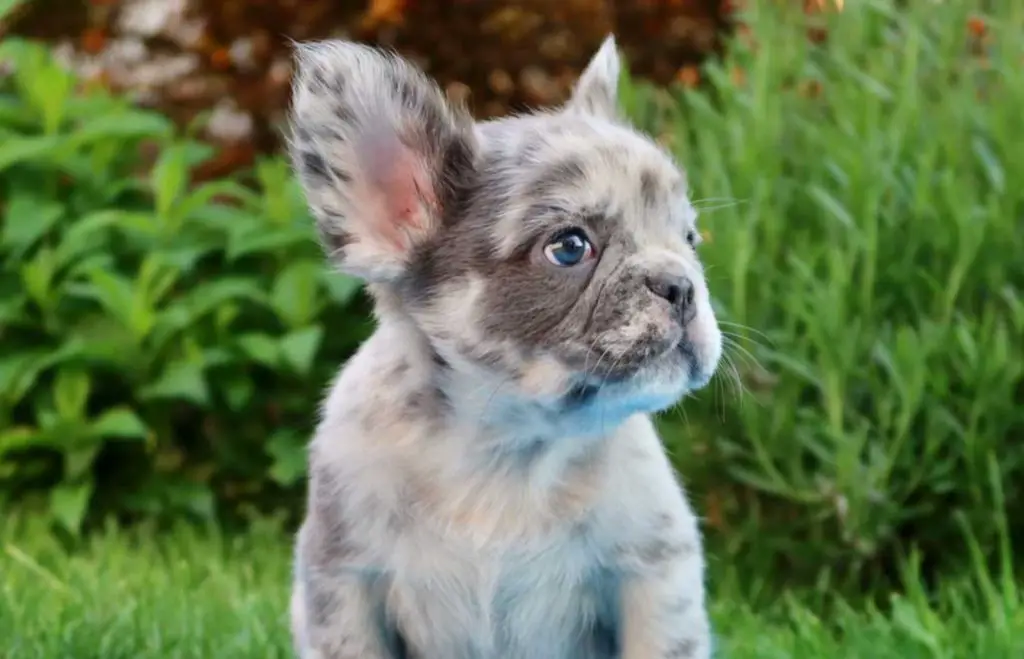
Different Kinds Of Merle French Bulldog Or Frenchton Colors Explained By A Breeder
Below is a video from a knowledgeable Merle French Bulldog breeder explaining some of the different Merle color variations. He is clearly a knowledgeable Merle Frenchie breeder, and there are some great takeaways in this short video:
How Much Are Merle French Bulldog Puppies?
Expect to invest more in one of these Merle Frenchie gems.
A lot more…
A Merle French Bulldog will absolutely cost you more than your average Frenchie. For example, I own a Chocolate Brindle Frenchie, and I paid $4,500 for him 5 years ago. I have seen Merle French Bulldogs for sale by quality breeders ranging from $6,500 to $12,000+. You can certainly pay even more than for a Merle Frenchie from an established, reputable breeder.

Why Are Merle Frenchies So Expensive?
This process required to properly breed a Merle Frenchie means that purchasing a Frenchie puppy is going to be more on the pricier side, meaning you could be paying thousands of dollars for a quality Merle Frenchie.
You shouldn’t aim to overpay, but you should also be very weary of too good a deal on a Merle Frenchie.
Watch Out For Merle French Bulldog Puppy Scams Online
There are many Merle French bulldog scams online, so buyers beware. You need to look for red flags. If you are seriously considering buying a Merle Frenchie, I highly recommend that BEFORE you send anyone any money, you should read this article about Frenchie scams.
Nothing is more sad than getting scammed by a fake breeder who swindles people out of their hard-earned money.
You not only lose your money, but it is a heart-breaking experience being swindled where you also don’t get the Frenchie puppy that you hoped for.
Don’t let this happen to you…
How Are Merle French Bulldogs Bred?
Here’s a quick genetics lesson on Merle French Bulldogs. The Merle pattern in Frenchies is caused by a dominant gene known as the “M” allele.
The unique coloring of Merle French Bulldogs is produced because of this “M” allele.
Frenchies with a single copy of the “M” allele (Mm) are considered Merle. Frenchies without the allele (mm) are considered non-Merle.
The video below is from a professional Merle French Bulldog breeder explaining how this unique Frenchie variation is bred. Merle French bulldogs can be tricky to breed, so care must be taken in the process.
Merle French Bulldog Breeding – About Merle Gene Inheritance
When a Merle French Bulldog (Mm) is mated with a non-Merle French Bulldog (mm), the expected outcome is that approximately half of the resulting puppies will possess the “M” allele, making them Merle (Mm), while the other half will inherit the non-Merle allele, making them non-Merle (mm).
In simple terms, a pairing between a Merle and a non-Merle will yield a combination of both Merle and non-Merle puppies.
Don’t Breed A Merle French Bulldog With Another Merle French Bulldog – Double Merle Breeding
When two dogs with the merle pattern in their genetics are intentionally mated together, each puppy born in the litter faces a 25% probability of inheriting the merle gene from both parents. This inheritance results in a specific category of offspring known as double merles, also called homozygous merles. Double merles typically exhibit a predominantly white coat, one with no dark patches.
It’s crucial to emphasize that mating two Merle French Bulldogs (MM) can lead to the birth of double Merle dogs, which are genetically burdened with an increased likelihood of health issues. Double Merle Frenchies are fraught with health issues, such as blindness, deafness, and much more.
The History Of Merle French Bulldog Breeding
Breeding Merle French Bulldogs began in the early 1900s when a breeder noticed that his dogs had unusual coloring. He identified it was due to the Merle gene. He started breeding these Merle French bulldogs to see what would happen.
Over time, he found out that if he bred a male Merle with a female without the Merle gene, then half of the puppies would have the Merle gene.
Unfortunately, many of those puppies were born with birth defects such as cleft palate and deformed limbs.
To prevent this problem, Merle French bulldog breeders started using DNA testing to find out which dogs carried the Merle gene. Today, most Merle French Bulldogs are tested before they are bred.
If you want to get a Merle Frenchie puppy from a reputable breeder, ask about their health records. Ask how long they’ve been breeding Merle French Bulldogs and how many litters they have produced.
On top of that, it would be ideal to see what kind of experience people have had who have purchased Merle Frenchies from that particular breeder and if their dogs are still healthy today.
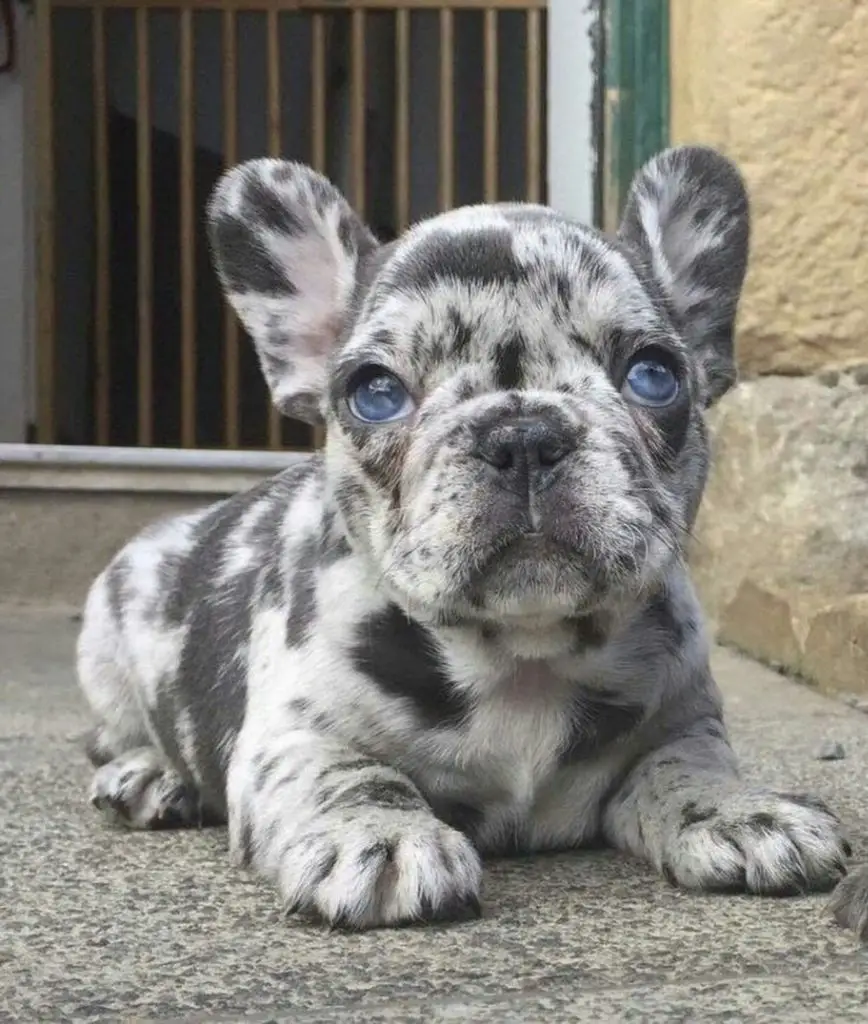
What Is The Life Expectancy Of A Merle French Bulldog?
The average lifespan for a Merle French Bulldog is 8-12 years. This means that a healthy Merle French Bulldog has a good chance of living into its senior years. However, it’s important to remember that not all breeds live as long as others.
Other factors that affect a dog’s longevity include its diet and exercise habits. Therefore, ensuring your Merle French Bulldog is in good health will ensure that it can live a long and happy life.
Are Merle French Bulldogs Good With Children?
Yes! Many parents report that their children love playing with their Merle French Bulldog. Merle Frenchies are very affectionate and friendly towards kids.
Frenchies, if socialized properly, also enjoy being around other animals. Most French Bulldogs are great with cats and small dogs.
Are Merle French Bulldogs Rare?
Merle French Bulldogs are very rare! They are known as one of the rarest Frenchie variations out there, closely followed by the Fawn and Platinum-colored Frenchies.
The fact is that Merle French Bulldog puppies take planning, knowledge, preparation, and genetic testing to come into existence. Merle Frenchies are rare and beautiful fur balls!
As mentioned above, the genetic testing required to properly breed a healthy Merle French Bulldog is quite involved, and this contributes to the rarity of Merle French Bulldogs.
Merle French Bulldog Health Issues
As with most dogs, health issues can occur when owning a French Bulldog, but this breed has a higher risk of encountering certain issues. Some common problems include hip dysplasia, allergies, ear infections, eye problems, heart disease, and respiratory diseases. To get a healthy Merle French Bulldog puppy, proper breeding practices must be strictly adhered to.
Below are some of the common health issues Merle Frenchies can have:
Merle French Bulldog Joint Problems
Joint problems tend to be the most common issue with Frenchies in general. These include hip and elbow dysplasia, arthritis, and luxation.
Breathing Issues In Merle French Bulldogs
They can also experience issues with their breathing. These issues include illnesses such as tracheal collapse, stenotic nares, and an elongated soft palate.
Spinal Issues In Merle French Bulldogs
Spinal issues are also common with Frenchies, and you should look out for issues such as degenerative myelopathy and intervertebral disc disease.
Eye Issues In Merle French Bulldogs
As mentioned above, eye issues are also common in French Bulldogs in general, not just the Merle. These include entropion, where the eyelid begins to roll forward, and cataracts, among others.
Ear Defects In Merle French Bulldogs
Merle French Bulldogs have a high rate of hearing loss. They are susceptible to this either at birth or later on in their life. If you notice that your Frenchie doesn’t seem to hear or respond to sounds, then you need to take him to the vet right away.
Hearing loss can lead to other health complications if left untreated, so it’s important to get your Frenchie checked out.
Final Thoughts About The Merle French Bulldog
To conclude, we hope that you enjoyed this guide about the Merle French Bulldog. Finding a reputable Merle French Bulldog is critically important and the first step in finding the perfect Frenchie for your family. We know how much work goes into raising a Frenchie family member, and we want to help you do that by providing as much information as possible.



